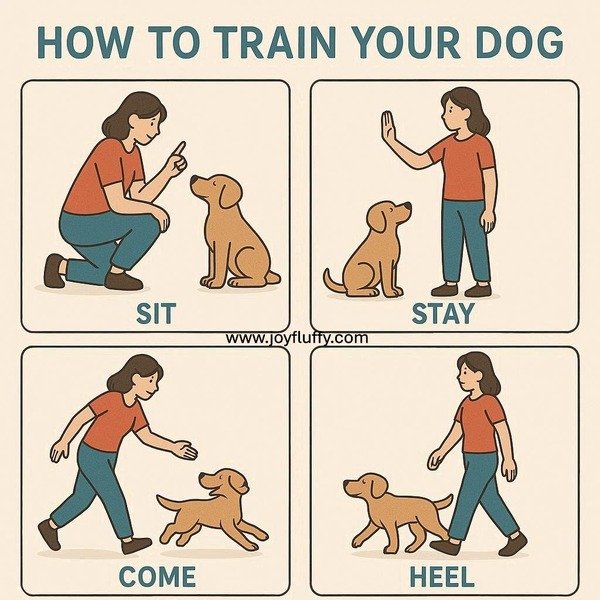How to Train Your Dog: Basic Commands (Sit, Stay, Come, Heel)
🐕 Dog Training Mastery
Master the Four Essential Commands Every Dog Should Know
Picture this: You’re walking your dog when suddenly a squirrel darts across the path. Your well-trained pup looks at you, awaits your signal, and calmly continues walking by your side instead of lunging after the distraction. This isn’t just a dream – it’s the reality of proper dog training.
Dog training isn’t just about teaching tricks – it’s about creating a language between you and your furry best friend. Every dog, regardless of age or breed, benefits from learning basic obedience commands that ensure safety, improve behavior, and strengthen the incredible bond you share.
In this comprehensive guide, we’ll walk you through four essential commands every dog should know: Sit, Stay, Come, and Heel. Whether you’re a first-time dog owner or looking to refresh your training skills, these step-by-step instructions will set you and your pup up for success.
Why Dog Training Matters
🗣️ Builds Clear Communication
Training creates a common language between you and your dog. When your dog understands what you’re asking, both of you feel less frustrated and more connected. Clear communication reduces anxiety and confusion for your pet.
🛡️ Ensures Safety for Everyone
A well-trained dog is a safe dog. Commands like “Stay” can prevent your pup from running into traffic, while “Come” ensures they return to you in potentially dangerous situations. These skills can literally save your dog’s life.
🎯 Prevents Behavioral Problems Early
Consistent training prevents many common behavioral issues before they develop. Dogs with clear boundaries and expectations are less likely to develop destructive habits like excessive barking, jumping on people, or pulling on walks.
✨ Improves Quality of Life
Trained dogs are welcome in more places and situations. They can accompany you on adventures, meet new people confidently, and integrate better into your daily routine. This freedom enriches both your lives significantly.
When and How to Start Training
Ideal Age for Training
Puppies can start learning basic commands as early as 8 weeks old. Their brains are like sponges, absorbing new information quickly. However, adult dogs are equally capable learners – it’s never too late to start training!
🕒 Key Timeline:
- 8-12 weeks: Begin with simple commands like “Sit”
- 12-16 weeks: Add “Stay” and “Come”
- 4-6 months: Introduce “Heel” and refine all commands
- Adult dogs: Can learn at any age with patience and consistency
Training Frequency
Short, frequent training sessions work better than long, infrequent ones. Aim for 5-15 minute sessions, 2-3 times daily. This prevents mental fatigue and keeps your dog engaged and excited to learn.
General Training Principles
Positive Reinforcement Works Best
Reward good behavior immediately with treats, praise, or play. This approach builds confidence and creates positive associations with training. Dogs learn faster and retain information better when training is enjoyable.
🎁 Effective Rewards:
- High-value treats (small, soft, tasty)
- Enthusiastic praise (“Good dog!”)
- Favorite toys or play time
- Physical affection (pets, belly rubs)
Timing is Everything
Reward your dog within 2-3 seconds of the desired behavior. This clear timing helps your dog understand exactly what they did right. Late rewards can confuse the learning process.
Consistency is Key
All family members should use the same commands, hand signals, and rewards. Mixed messages slow down learning and frustrate your dog. Establish clear rules and stick to them every time.
Patience Prevents Problems
Every dog learns at their own pace. Some pick up commands in days, while others need weeks of practice. Stay calm and positive – your dog can sense your emotions and will respond better to patient, encouraging training.
Avoid Punishment-Based Methods
Focus on rewarding good behavior rather than punishing mistakes. Positive training methods are more effective and maintain your dog’s trust and confidence. Redirect unwanted behavior and reward the correct response instead.
Step-by-Step Training for Basic Commands
Teaching “Sit”
Why Start with Sit: This foundational command is easy to teach and builds confidence for both you and your dog.
📋 Step-by-Step Instructions:
- Hold a treat close to your dog’s nose – let them smell but not grab it
- Slowly lift the treat over their head – their bottom should naturally lower to the ground
- The moment their bottom touches the ground, say “Sit!”
- Immediately give the treat and praise enthusiastically – “Good sit!”
- Repeat 5-10 times per session until they respond to the verbal cue alone
✋ Hand Signal:
Raise your hand with palm up as you say “Sit.” This visual cue helps reinforce the verbal command.
⚠️ Common Mistakes to Avoid:
- Never push your dog’s bottom down – let them do it naturally
- Don’t repeat the command multiple times – say it once and wait
- Avoid training when your dog is overly excited – choose calm moments
💡 Pro Tips:
- Practice before meals when your dog is naturally motivated by food
- Start indoors in a quiet space with minimal distractions
- Once mastered indoors, gradually practice in different locations
Teaching “Stay”
Why Stay Matters: This command teaches impulse control and can prevent dangerous situations.
📋 Step-by-Step Instructions:
- Start with your dog in the “Sit” position
- Hold your hand up like a stop sign and take one small step backward
- Wait 2-3 seconds, then return and reward – don’t let them come to you
- Use a release word like “Okay” or “Free” to end the stay
- Gradually increase distance and duration – add one step and one second at a time
📈 Building Duration and Distance:
- Week 1: 3-5 seconds, 1-2 steps away
- Week 2: 10-15 seconds, 3-4 steps away
- Week 3: 30+ seconds, across the room
Always return to your dog rather than calling them to you
⚠️ Common Mistakes to Avoid:
- Moving too fast too soon – build slowly for lasting success
- Forgetting the release word – your dog needs to know when “Stay” ends
- Getting frustrated if they break the stay – simply start over calmly
Teaching “Come” (Recall)
🚨 Critical Safety Note:
A reliable recall command can save your dog’s life in emergency situations.
📋 Step-by-Step Instructions:
- Start in a safe, enclosed area or use a long training leash
- Get down to your dog’s level and use an excited, happy voice – “Come!”
- Pat your legs, clap, or make yourself interesting – make coming to you the best thing ever
- When they reach you, reward immediately with treats and enthusiastic praise
- Never call your dog to come for something they perceive as negative (bath time, end of play)
🎓 Advanced Recall Training:
- Practice with mild distractions – other people, toys, sounds
- Use a long training leash for outdoor practice until recall is reliable
- Always make coming to you rewarding – even if it took them a while to respond
⚠️ Common Mistakes to Avoid:
- Never punish your dog when they finally come – even if they took too long
- Don’t chase your dog if they don’t come – this turns it into a fun game for them
- Avoid calling “Come” unless you can enforce it – practice in controlled environments first
Teaching “Heel” (Walking Nicely on Leash)
🎯 Goal:
Your dog walks calmly beside your left leg without pulling ahead or lagging behind.
📋 Step-by-Step Instructions:
- Start indoors or in a quiet outdoor area
- Hold treats at your side where you want your dog’s head to be
- Take a few steps forward – if your dog stays in position, reward immediately
- If they pull ahead, stop walking immediately – wait for them to return to your side
- Change directions frequently to keep your dog focused on you
- Gradually reduce treats as the behavior becomes consistent
🦮 Leash Training Tips:
- Use a standard 6-foot leash – retractable leashes make training harder
- Keep the leash loose – tension creates pulling
- Be patient with puppies – their attention spans are shorter
🎓 Advanced Heel Training:
- Practice around distractions – other dogs, people, interesting smells
- Vary your walking pace – slow, normal, and fast
- Add turns and stops to keep your dog engaged
⚠️ Common Mistakes to Avoid:
- Don’t let your dog drag you – stop and wait for them to return
- Avoid jerking the leash – use positive redirection instead
- Don’t skip the indoor practice – master the basics before adding distractions
Common Training Challenges & Solutions
😵 Challenge: Dog Gets Easily Distracted
Solution: Start training in a boring, quiet environment. Gradually add distractions only after your dog masters the command in easy settings. Use higher-value treats in distracting environments.
🍖 Challenge: Not Food Motivated
Solution: Try different reward types – some dogs prefer toys, play time, or physical affection. Find what makes your individual dog excited and use that as motivation.
🌳 Challenge: Inconsistent Response Outdoors
Solution: Outdoor environments have many more distractions. Go back to basics outside and practice each command as if your dog is learning it for the first time. Be patient and consistent.
😤 Challenge: Owner Frustration
Solution: Dogs are incredibly sensitive to human emotions. Take breaks when you feel frustrated. Training should be enjoyable for both of you. Consider shorter, more frequent sessions.
Extra Success Tips for Training Excellence
- Keep Sessions Short and Sweet: 5-15 minute sessions prevent mental fatigue and keep training fun. Multiple short sessions throughout the day are more effective than one long session.
- Practice Daily for Best Results: Consistency beats intensity in dog training. A few minutes of daily practice will yield better results than sporadic long training sessions.
- Mix Training with Playtime: Make training feel like a game by incorporating play breaks and keeping the mood light and positive. Happy dogs learn faster and retain information better.
- Train in Various Environments: Once your dog masters a command at home, practice in different locations – the park, friend’s houses, busy sidewalks. This helps generalize the behavior.
- Track Your Progress: Keep a simple training journal noting what you practiced and how your dog responded. This helps you identify patterns and celebrate improvements.
- Socialization Goes Hand-in-Hand: Expose your dog to different people, animals, and situations while practicing commands. Well-socialized dogs are easier to train and more confident.
When to Seek Professional Help
Consider Professional Training If:
- Your dog shows signs of aggression during training
- Basic commands aren’t improving after 4-6 weeks of consistent practice
- You feel overwhelmed or unsure about your training methods
- Your dog has specific behavioral issues beyond basic obedience
Frequently Asked Questions
- How long does it take to train a dog basic commands?
- Most dogs can learn basic commands within 2-4 weeks of consistent daily practice. However, every dog learns at their own pace – some may pick it up in days, while others need several months. Consistency and patience are more important than speed.
- What age should I start training my puppy?
- Puppies can start learning basic commands as early as 8 weeks old. Their brains are highly adaptable during this period. However, keep sessions very short (3-5 minutes) for young puppies as their attention spans are limited.
- Can older dogs learn new commands?
- Absolutely! Dogs of any age can learn new behaviors. While puppies may learn faster, adult and senior dogs are perfectly capable of mastering basic commands with consistent training and patience.
- What if my dog only listens at home but not outside?
- This is completely normal! Outdoor environments have many more distractions. Start practicing commands outside in quiet areas first, then gradually work up to busier environments. Use higher-value treats outdoors to compete with distractions.
- How many treats should I use during training?
- Use small, pea-sized treats to avoid overfeeding. You can give multiple small treats during a session – just adjust your dog’s regular meals accordingly. Gradually reduce treats as behaviors become consistent, replacing them with praise and petting.






